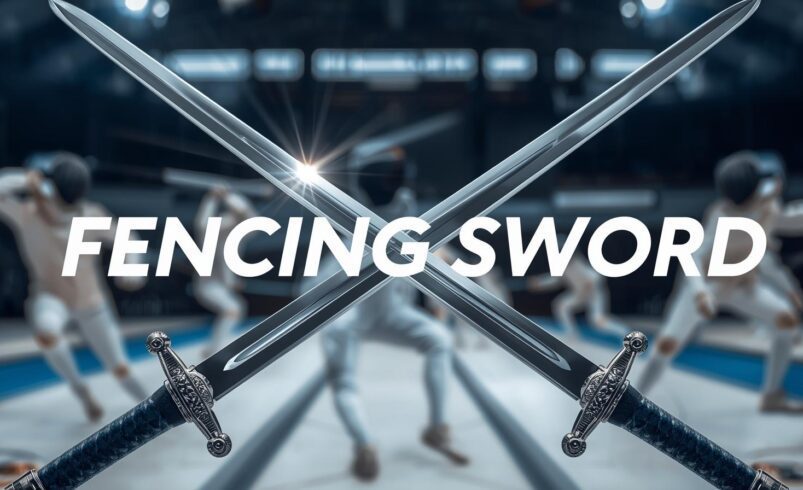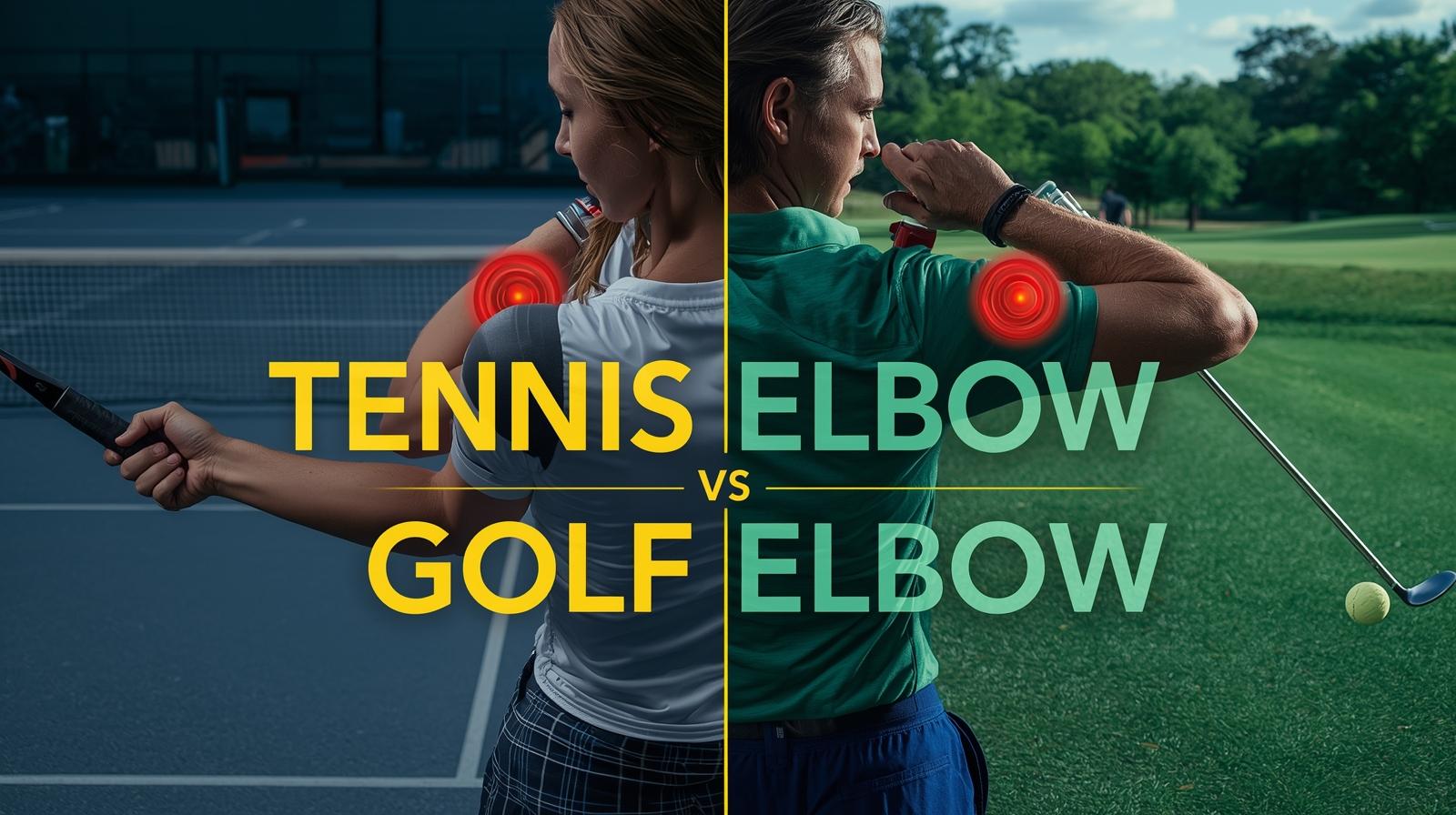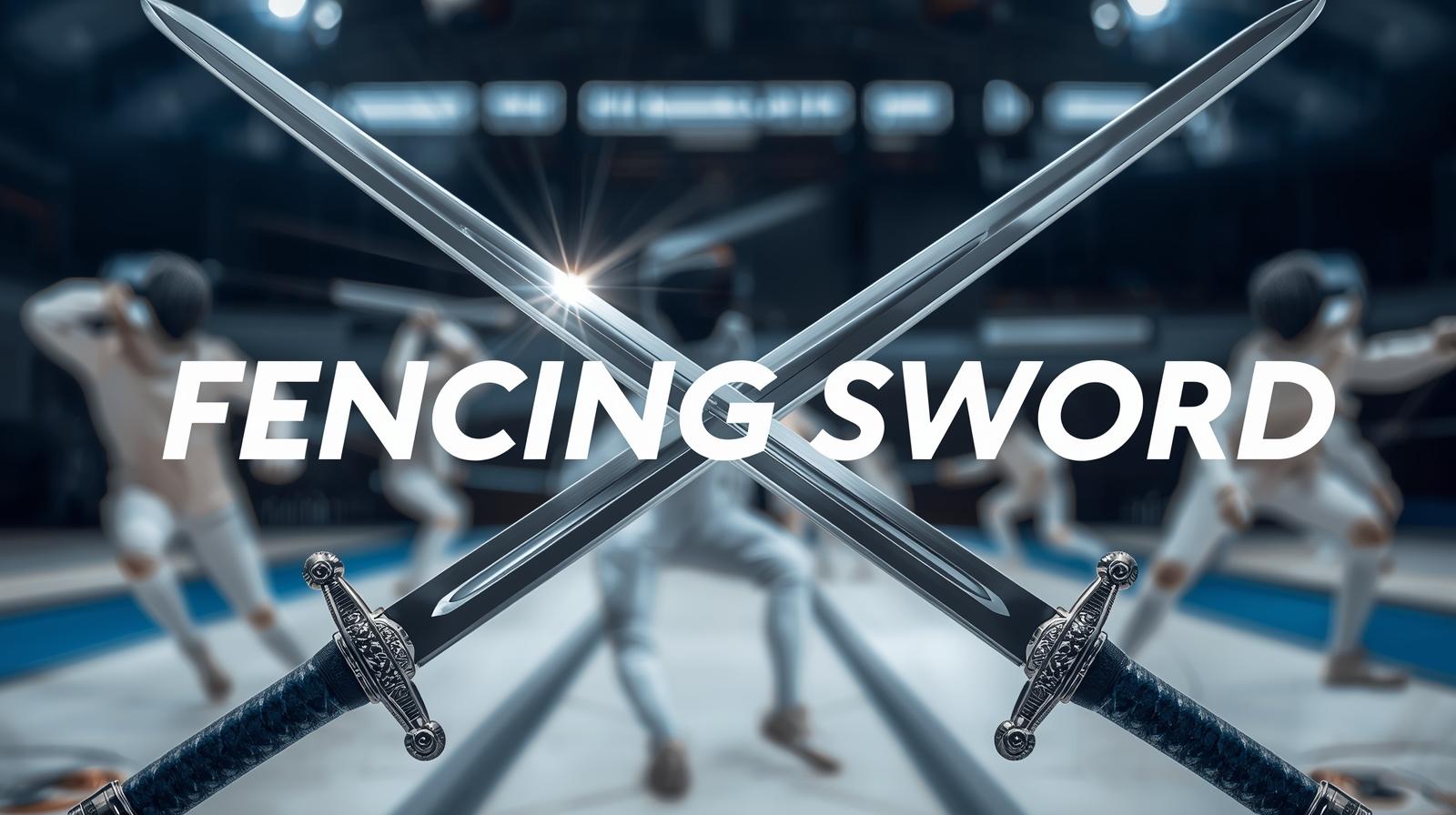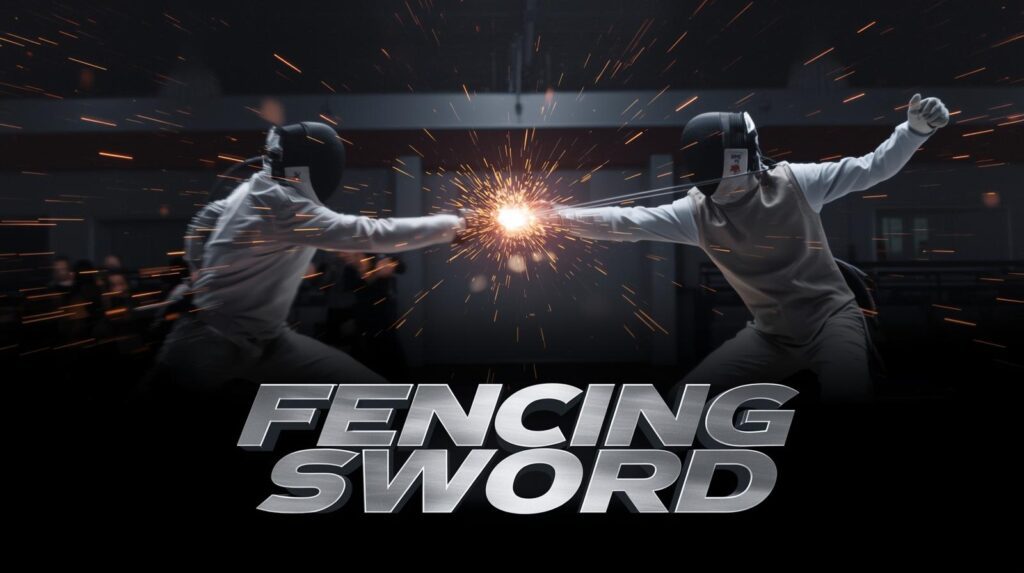
The metallic clash of steel, lightning-fast footwork, and the strategic interplay between two opponents that’s the world of the fencing sword. Whether you’re watching Olympic champions duel or contemplating your first lesson at a local club, understanding the fencing sword is key to appreciating this elegant and precise combat sport.
I still remember my first encounter with a fencing sword. Standing in a dimly lit gym, holding what felt like an extension of my own arm, I realized this was far more than a weapon it was a tool of precision, strategy, and centuries of martial tradition. That experience reshaped my understanding of what it truly means to master the art of fencing.
A Historical Perspective on the Fencing Sword
The fencing sword has undergone a dramatic evolution, transforming from a deadly dueling weapon into a sophisticated sporting instrument. Today’s blades are the result of centuries of innovation, rule refinement, and technological advancement.
Fencing traces its roots back to 15th-century Spain, where noblemen practiced swordsmanship for self-defense and honorable duels. Over time, the dangerous art of dueling gave way to a structured sport. What was once a matter of life and death became a refined discipline that emphasizes precision, speed, and tactical brilliance.
Modern fencing swords retain the elegance of their historical counterparts while integrating safety features, standardized dimensions, and lightweight designs. Each blade reflects a story of adaptation, balancing centuries of tradition with the demands of contemporary sport.
The Three Types of Fencing Sword
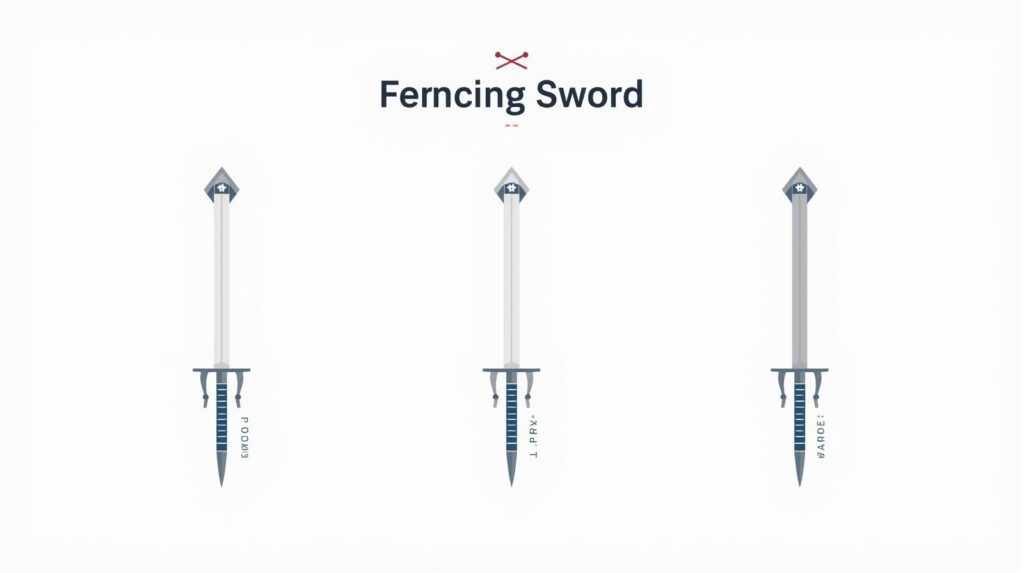
Foil: The Classical Fencing Weapon
The foil measures 110cm in total length with a 90cm blade and weighs less than 500g. This lightweight fencing sword is designed for precision thrusting, making it the ideal starting point for beginners learning proper technique.
The foil’s target area is restricted to the torso, excluding arms, legs, and head. This limitation teaches fencers to maintain proper form and strategic positioning. The foil uses right-of-way rules, meaning the fencer who initiates the attack has priority unless successfully parried.
From my experience coaching newcomers, the foil’s forgiving nature and clear rules make it perfect for developing fundamental skills. Students quickly grasp the concept of attack and defense, building confidence with each successful touch.
Épée: The Duelist’s Choice
The épée has a maximum size of 110cm, with a 90cm blade that is the most rigid among the three weapons, and weighs 0.77kg. This heavier fencing sword descended directly from dueling swords, offering a more realistic combat experience.
Unlike the foil, the épée allows touches to be scored anywhere on the opponent’s body, from toe to head. There’s no right-of-way rule if both fencers land touches simultaneously, both score points. This makes épée fencing a game of patience, precision, and tactical timing.
The épée’s heavier weight and stiffer blade demand greater arm strength and stamina. Advanced fencers appreciate how this fencing weapon rewards strategic thinking over pure speed.
Sabre: The Cavalry Sword
The sabre has a total length of 105cm with an 88cm blade, and the total weight must be less than 500g. This fencing sword is unique because it allows both cutting and thrusting actions, reflecting its cavalry warfare origins.
Sabre fencers can score with the blade’s edge, making it the fastest and most aggressive of the three disciplines. The target area includes everything above the waist torso, arms, and head. Like foil, sabre uses right-of-way rules, but the pace is significantly faster.
Watching sabre bouts is exhilarating. The explosive speed and dramatic sweeping motions make it the most visually dynamic form of fencing. However, this intensity requires exceptional reflexes and cardiovascular conditioning.
Comparing Fencing Sword Specifications
| Sword Type | Total Length | Blade Length | Weight | Target Area | Scoring Method |
| Foil | 110cm | 90cm | <500g | Torso only | Thrust (point) |
| Épée | 110cm | 90cm | <770g | Entire body | Thrust (point) |
| Sabre | 105cm | 88cm | <500g | Waist up | Cut & thrust |
Anatomy of a Fencing Sword
Every fencing weapon consists of several essential components, each serving a specific purpose in both functionality and safety.
The Blade: The long, flexible steel shaft that extends from the handle. Modern fencing blades are crafted from high-carbon steel, providing the perfect balance between flexibility and durability.
The Guard: Also called the bell or coquille, this curved metal shield protects the fencer’s hand from opponent strikes. The size varies by weapon épée guards are larger to protect against touches anywhere on the body.
The Grip: Where the fencer holds the weapon. Traditional grips include the French grip (straight handle) and pistol grip (contoured handle). Each offers different advantages in control and maneuverability.
The Pommel: The weighted end piece that secures the grip and provides balance to the fencing sword.
The Tip: For foil and épée, the tip contains an electronic scoring mechanism. Sabre blades have a blunt edge for safety while maintaining cutting action capabilities.
Choosing Your First Fencing Sword
Selecting the right fencing blade can feel overwhelming for newcomers. Here’s what I’ve learned guiding hundreds of students through this decision.
Start with Foil: Most coaches recommend beginners start with a foil. The lighter weight and straightforward rules help newcomers develop proper form without being overwhelmed by complex tactical scenarios.
Consider Physical Attributes: Taller fencers often gravitate toward épée, where reach provides a natural advantage. Shorter, faster fencers may excel in sabre, where explosive speed matters more than reach.
Try Before Buying: Most fencing clubs offer equipment rentals or trial periods. Spend time with each fencing weapon before investing in your own. The right sword should feel like a natural extension of your arm.
Quality Matters: Entry-level fencing swords cost between $50-$100, while professional-grade weapons can exceed $200. Invest in reputable brands that meet international federation standards.
For general sports equipment and gear information, visit alldandy to explore more options.
The Growing Popularity of Fencing Swords
With over 2 million practitioners worldwide and a rising female presence, fencing continues to grow as a sport blending discipline, strategy, and agility. This growth reflects increasing recognition of fencing’s unique benefits it combines physical conditioning with chess-like strategic thinking.
Fencing ranked a mere 2.5% injury rate, making it one of the safest combat sports available. This safety record, combined with fencing’s accessibility across age groups, contributes to its expanding appeal.
Olympic exposure has significantly boosted interest in the fencing sword. The Paris 2024 Olympics showcased incredible athleticism and dramatic competition, inspiring a new generation to pick up a fencer’s sword for the first time.
Maintenance and Care for Your Fencing Sword
Proper maintenance extends your fencing blade’s lifespan and ensures consistent performance. Here are essential care practices every fencer should follow.
After Each Use: Wipe down the blade with a clean, dry cloth to remove moisture and prevent rust. Check the tip for damage or wear, as a malfunctioning tip can lead to scoring errors during competition.
Weekly Inspection: Examine the blade for bends or kinks. While some flexibility is normal, sharp bends compromise structural integrity and safety. Inspect the guard for cracks and ensure the pommel remains securely tightened.
Storage: Store your fencing sword horizontally in a climate-controlled environment. Extreme temperatures and humidity accelerate metal degradation. Use a weapon bag to protect against physical damage during transport.
Professional Servicing: Have your fencing weapon professionally inspected before major competitions. Certified armorers can identify issues invisible to untrained eyes and ensure your equipment meets regulatory standards.
Training Techniques with the Fencing Sword
Mastery of any fencing weapon requires dedicated practice and progressive skill development. Here’s how experienced fencers recommend approaching training.
Footwork First: Before worrying about blade work, develop solid footwork. The fencing sword is only effective when paired with proper positioning and movement. Practice advances, retreats, lunges, and lateral movements until they become second nature.
Blade Work Drills: Start with basic parries and attacks against a stationary target. Progress to partner drills that incorporate reaction time and distance judgment. Focus on smooth, controlled movements rather than speed precision comes before velocity.
Tactical Training: Study video footage of elite fencers. Notice how they use their fencing blade to control distance, create openings, and exploit opponent weaknesses. Chess players study master games; fencers should study master bouts.
Physical Conditioning: Fencing demands explosive power, cardiovascular endurance, and flexibility. Incorporate plyometric exercises, interval training, and stretching routines specifically designed for fencers.
The Psychology Behind the Fencing Sword
Mental preparation separates good fencers from great ones. The fencing sword becomes an extension not just of your arm, but of your strategic mind.
Pattern Recognition: Experienced fencers read opponent tendencies within seconds. Does their blade drop before attacking? Do they favor certain distance ranges? The fencing weapon becomes a tool for gathering intelligence.
Emotional Control: In the heat of competition, maintaining composure while holding a fencing sword is challenging. Successful fencers develop emotional resilience, staying calm whether winning or losing.
Visualization: Elite athletes visualize success. Mentally rehearse your movements with the fencer’s sword the weight in your hand, the target in sight, the perfect execution. This mental practice translates to physical performance.
Common Mistakes with Fencing Swords
Even experienced fencers occasionally fall into bad habits. Recognizing these mistakes helps you avoid them.
Gripping Too Tightly: Beginners often death-grip their fencing blade, causing arm fatigue and reducing control. The weapon should rest comfortably in your hand, held firmly but not tensely.
Incorrect Distance Management: The most beautiful fencing sword technique fails if executed at the wrong distance. Learn your weapon’s effective range and maintain proper spacing.
Neglecting Defense: Aggressive fencers often focus exclusively on attacking. Remember that defense wins championships every offensive action creates defensive vulnerabilities.
Poor Body Alignment: Your fencing sword should extend naturally from your body’s centerline. Twisting or overreaching compromises balance and power.
The Future of the Fencing Sword
Technology continues transforming the fencing weapon. Modern materials science produces lighter, stronger blades. Electronic scoring systems eliminate human judgment errors. Virtual reality training programs allow fencers to practice against AI opponents programmed to mimic world champions.
Carbon fiber composites may eventually replace traditional steel in fencing blade construction, offering superior strength-to-weight ratios. Biomechanical analysis helps fencers optimize their technique with data-driven insights impossible just a decade ago.
Despite technological advancement, the fundamental challenge remains unchanged: two fencers, two swords, one victor. The fencing sword’s elegant simplicity ensures its enduring appeal.
Conclusion: Your Journey with the Fencing Sword
The fencing sword is more than just athletic equipment it’s a gateway to personal growth, strategic thinking, and physical mastery. Whether you step onto the piste with a foil, épée, or sabre, you’re entering a tradition that has spanned centuries and crossed continents.
Every fencer remembers their first scored touch, their first competition, and their first victory. These milestones mark a journey that develops not only athletic skill but also discipline, resilience, and character.
The true beauty of the fencing sword lies in its dual nature: it is at once simple and intricate, ancient and modern, individual and universal. As your skills evolve, so will your relationship with your blade, reflecting your growth both as a fencer and as a person.
Frequently Asked Questions
Q: Which fencing sword is best for beginners?
Most coaches recommend starting with foil because it’s the lightest fencing weapon and teaches fundamental techniques through its structured right-of-way rules. The restricted target area helps beginners focus on proper form without becoming overwhelmed by tactical complexity.
Q: How long does a fencing sword last?
A well-maintained fencing blade typically lasts 2-5 years depending on usage frequency and intensity. Competitive fencers who train daily may replace their weapon annually, while recreational fencers might use the same sword for many years. Regular inspection and maintenance significantly extend lifespan.
Q: Can you use the same fencing sword for all three disciplines?
No, each fencing weapon is specifically designed for its discipline and cannot be used interchangeably. Foil, épée, and sabre have different dimensions, weights, scoring mechanisms, and target areas. Using the wrong sword would violate competition rules and compromise technique development.
Q: What’s the most challenging aspect of mastering a fencing sword?
Distance management remains the most difficult skill to master with any fencing blade. Understanding exactly when you’re in range to score while remaining outside your opponent’s range requires thousands of hours of practice and exceptional spatial awareness.
Q: How do I know if my fencing sword needs replacement?
Replace your fencing weapon if you notice significant bends that don’t straighten, cracks in the guard, a loose pommel that won’t tighten, or malfunctioning electronic components. Additionally, if your blade feels different during training either too soft or too rigid it may have sustained internal damage requiring replacement.
What will your first touch with a fencing sword feel like?

